Wilderness Adventures
Preparing for a wilderness trip, gear and safety
Preparing for a trip into the wilderness can reduce the risk of ending up in a potentially dangerous situation and change it to a situation where you just have to stay a little longer in the nature than originally planned.
Planning is everything
When planning for a hike or hunt, no matter if it is just a daytrip or for a longer period, it is wise to follow the same methodology. One of the most valuable lessons is that you cannot plan for everything. But if you have a general plan, it is much easier to deviate from it, instead of having to make a plan in the field.
I have made a ‘Travel Information Plan’ which is a checklist for me. It is several pages that I can hand over to my relatives, or to the local authorities in the area I am visiting.
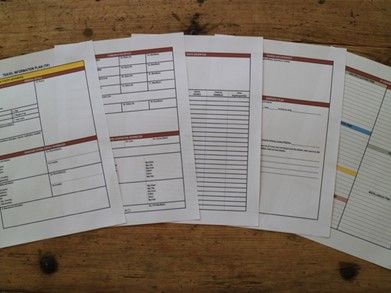
"I have made a 'Travel Information Plan' which is a checklist for me"
//THE RULE OF THREE//
The plan provides them with all the essential information about me, my trip, my plans and how I will react in an emergency. When I fill out the papers, I ask myself a lot of questions, both taken from the Travel Information Plan and from a survival rule called ‘The Rule of Three’, which I will cover in more detail below.
By answering those questions on paper, I am basically able to cover most emergencies and make sure I have packed all my gear and made a solid plan for my trip.
Questions to ask
Depending on where you are going and how well you know the area beforehand, there are different questions to ask. If you know the area as well as your own back pocket, you can, of course, do the planning much faster, compared to if it is unknow terrain for you.
Visiting unknown terrain is always great but can be a challenge if you come unprepared. The way you prepare, will first be to gather as much information about the area as possible.
You can use Google for a lot of the answers, but the best thing is if you have a friend who has previously been to the area. If you are member of an outdoor community on social media, you can also start your questions there.
The questions may include:
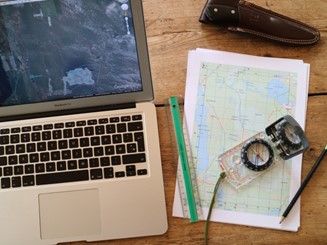
Where am I going? Do you have a map of the area and how the terrain is to hike in? If you have access to an updated map of the area, you can see in advance what the terrain is like, where there are water sources, wooded areas for shelter, roads, and where you will find the nearest settlement or small wilderness cabins that can be used for emergency shelters.
If you do not have access to a printed map, you can use Google Earth or even better use some of the Nordic map sites found for each country. Most of them allow you to select and print maps in different scales covering the area you are planning to visit. Simply register as a user, for most sites it is free, and then you can make maps you can print yourself.
//MAPS//
You can of course buy maps in many of the outdoor stores in the vicinity of the area you are visiting, and there are many digital maps for different GPS’s available online. Remember to bring the maps on your hike and know how to use them.
Web pages for generating maps
- Sweden: https://www.lantmateriet.se
- Norway: https://www.norgeskart.no
- Denmark: https://sdfekort.dk/
- Finland: https://www.maanmittauslaitos.fi
When buying or printing your own maps, remember to add extra maps of the surrounding area, so you cover the whole area from where you start and to where you plan to hike. I normally make my maps 5-10 km larger in radius, so I can use them if I get lost.
Have you previously been hiking in the area?
If it was during the same period as you are planning, you will gain a lot of information about the climate, the state of the roads and terrain, how much water is in the rivers and lakes, etc.
What did you bring?
What did you use the most, and was there something you were missing during the hike, or something you did not need? The answers to this question can tell you if there is anything special you need to bring. If other people were missing it during the hike, then the likelihood that you also will be missing it is relatively high.
Is there cellular coverage throughout the area?
If there is no cellular coverage from your own cellular provider, then think about how your relatives can know that you are in good health. Maybe you have instructed them to contact the rescue services if they do not hear from you within a defined period. If you are lucky you can buy a local sim card with coverage or you might need to acquire a personal locator beacon.
All in the details
After I have collected as much information as possible, I begin to plan my trip. I check the maps, plot the route, start filling out my Travel Information Plan, and begin to think about what gear to bring.
My backpack is determining how much gear I can bring. When I was younger, I had a 120L pack. And guess what. I filled it to the gills. It was packed with as much gear I could fit into it, and it was heavy as a ton of bricks.
Getting older and more experienced, I have started to cut down on the gear. I am by no means an ultra-light packer, but I take a good look at every item, and decide is it is necessary to bring. A lot of the gear I am carrying is a mix of experience in the field, my wish to test new gear and the need to get a good night of sleep.
When I start to pack, I lay out all the gear and clothes I would like to bring. Then I look at the pack I am planning to use. Normally I have at least the double amount of gear, that my pack can carry. So now it is sorting time. This is when the ‘The Rule of Three’ comes into play.
‘The Rule of Three’
With this simple rule you get a good idea of what to focus on, when packing your gear for a trip to the wilderness. You should see the rules as a rough rule of thumb and not as an absolute law.
You can survive three seconds without your mother
This is of course figuratively speaking. If you are in a situation where you are in a survival situation, your positive mental attitude and positive outlook on the situation is crucial.
You must keep up your courage and constantly try to solve the problems while maintaining the belief that you will be saved. There are countless examples every year, where people who are lost or injured in the wilderness, survive, even if all the odds are against them.
All the gear I choose covering this rule, are not covered by the other rules. It could be various gear that is just nice to bring, to make my hike more comfortable. It could be a book, a camera, candy, ‘wilderness money’ (toilet paper) or other items.
You can survive three minutes without oxygen
Oxygen supports life, and if you do not have oxygen then you lose your life. This rule is, of course, based on first aid. To be able to perform lifesaving first aid should be something all persons should be able to do.
First aid equipment and knowledge of first aid should a
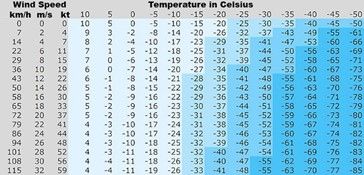
lways be one of your top priorities, especially if you are hiking in desolate areas.
You can survive three hours without a shelter
If you are unlucky and are in a place where it is cold, the wind is blowing and you are at the same time wet, you will be incredibly quickly cooled down due to the wind-chill factor.
Therefore, you should know what the normal temperature and weather are in the area you will be staying. That way you can plan what to bring in extra clothing, and maybe extra material to make a shelter.
In a true survival situation, you can usually settle for some 550 cord and a rescue blanket to survive. It is not the Hilton, but you can survive with it and it does not take up much space. You can even get small sleeping bags in the same material as the rescue blanket, which do not take up more space than a coke can and are very lightweight. These two things alone will be able to help you should the unforeseen happen, and you are forced to spend a night or two in the wild.
The best inner layer of clothing to bring if it is cold is clothing made from wool or merino wool. Merino wool has great insulating effect compared to weight and it does not transfer the smell of sweat. Technical wool is ok, too. Wool can insulate even if it is wet, which cotton cannot.
You need to have as many layers of clothing as you consider necessary to keep you dry and warm. It is very advisable to bring an outer layer that is wind and waterproof. In an emergency you have a simple and insulating shelter, if you have not brought anything else.
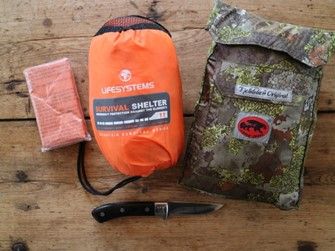
You can survive three days without water
Water is very important for our organism to maintain the proper level of hydration. I usually consume at least 1.5 - 2.5 liters of fluid a day, during moderate physical activity. If the temperature is higher, I drink more, just as I drink more if I work and sweat more.
What happens if you become dehydrated?
Even when you are about 2% dehydrated you will feel thirsty and a little dry mouth. You may lose your appetite and up to 30% of your performance, depending on how hot and dehydrated you are.
When you are approx. 5% dehydrated you may find that your heart beats faster, you will experience dizziness and your urine will become very dark and start to smell strongly. When you are more than 15% dehydrated you will find that your vision is affected, you will have a very hard time concentrating and making rational decisions.
Preventing dehydration
When you drink water, it is not beneficial to drink a liter at one time, then wait a few hours and then drink a liter again in 5 minutes. Your organism can absorb about 1 liter of liquid in one hour, spread over the entire hour. Of course, this does not mean you have to drink 1 liter of liquid every hour, but you should distribute the fluid intake throughout the day.
If you are becoming dehydrated, you can also help yourself by drinking a salt/sugar solution in one liter of water. It consists of one liter of water, two tablespoons of plain sugar and a half teaspoon of salt. If you have trouble drinking the salty water, you can eat chips instead, or add a drink of lemon or orange juice to blend with the salty taste. Alternatively, you can buy bags with pre-mixed rehydration salts and sugar, ready to be mixed with water.
Of course, you also need to think about what kind of water you drink if you drink it from a source in the nature. There are a lot of different water purification kits available in many price ranges and sizes, most of which work great, so it is up to you to choose the one that suits you best.
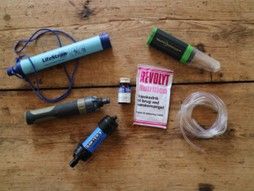
You can survive three weeks without food
Many will be surprised to learn how long you can survive without food. Of course, your energy level will drop quickly if you get no food, but you can easily go a few days without any significant discomfort.
When watching different televised survival shows, food is always one of the first things the participants think about. But it is not as important as shelter and water in the first days of survival.
If you are stranded in the wilderness, with no food at all, then you need to conserve energy and concentrate on making a proper shelter and obtaining water so that you are dry and properly hydrated. Food is not your first priority.
Final words
In the above, I have covered the rule of three with stuff for positive mental attitude, first aid gear, shelter materials, water/water purification and some food.
In addition, I have various signaling means and other necessary equipment based on where I am going to stay, how long I have planned to be away and what I know about the area in advance.
Written in corporation with Claus S. Andersen who is a certified SERE (Survival, Evasion, Resistance, Extraction) instructor from the Swedish Defense Forces Survival School in Karlsborg, Sweden. He has participated in and worked as an instructor on numerous wilderness courses in Europe and USA.